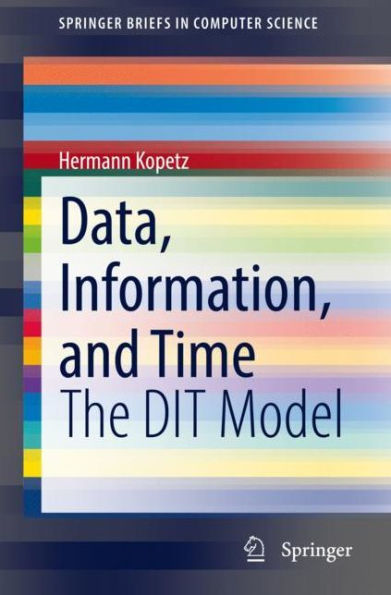Data, Information, and Time: The DIT Model
This SpringerBrief presents the data- information-and-time (DIT) model that precisely clarifies the semantics behind the terms data, information and their relations to the passage of real time. According to the DIT model a data item is a symbol that appears as a pattern (e.g., visual, sound, gesture, or any bit pattern) in physical space. It is generated by a human or a machine in the current contextual situation and is linked to a concept in the human mind or a set of operations of a machine. An information item delivers the sense or the idea that a human mind extracts out of a given natural language proposition that contains meaningful data items. Since the given tangible, intangible and temporal context are part of the explanation of a data item, a change of context can have an effect on the meaning of data and the sense of a proposition.
The DIT model provides a framework to show how the flow of time can change the truth-value of a proposition. This book compares our notions of data, information, and time in differing contexts: in human communication, in the operation of a computer system and in a biological system. In the final Section a few simple examples demonstrate how the lessons learned from the DIT-model can help to improve the design of a computer system.
1140865637
The DIT model provides a framework to show how the flow of time can change the truth-value of a proposition. This book compares our notions of data, information, and time in differing contexts: in human communication, in the operation of a computer system and in a biological system. In the final Section a few simple examples demonstrate how the lessons learned from the DIT-model can help to improve the design of a computer system.
Data, Information, and Time: The DIT Model
This SpringerBrief presents the data- information-and-time (DIT) model that precisely clarifies the semantics behind the terms data, information and their relations to the passage of real time. According to the DIT model a data item is a symbol that appears as a pattern (e.g., visual, sound, gesture, or any bit pattern) in physical space. It is generated by a human or a machine in the current contextual situation and is linked to a concept in the human mind or a set of operations of a machine. An information item delivers the sense or the idea that a human mind extracts out of a given natural language proposition that contains meaningful data items. Since the given tangible, intangible and temporal context are part of the explanation of a data item, a change of context can have an effect on the meaning of data and the sense of a proposition.
The DIT model provides a framework to show how the flow of time can change the truth-value of a proposition. This book compares our notions of data, information, and time in differing contexts: in human communication, in the operation of a computer system and in a biological system. In the final Section a few simple examples demonstrate how the lessons learned from the DIT-model can help to improve the design of a computer system.
The DIT model provides a framework to show how the flow of time can change the truth-value of a proposition. This book compares our notions of data, information, and time in differing contexts: in human communication, in the operation of a computer system and in a biological system. In the final Section a few simple examples demonstrate how the lessons learned from the DIT-model can help to improve the design of a computer system.
54.99
In Stock
5
1

Data, Information, and Time: The DIT Model
75
Data, Information, and Time: The DIT Model
75Paperback(1st ed. 2022)
$54.99
54.99
In Stock

Product Details
| ISBN-13: | 9783030963286 |
|---|---|
| Publisher: | Springer International Publishing |
| Publication date: | 03/18/2022 |
| Series: | SpringerBriefs in Computer Science |
| Edition description: | 1st ed. 2022 |
| Pages: | 75 |
| Product dimensions: | 6.10(w) x 9.25(h) x (d) |
About the Author
From the B&N Reads Blog
